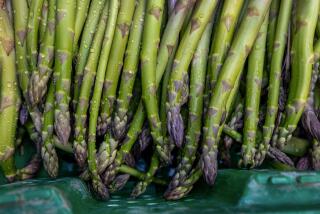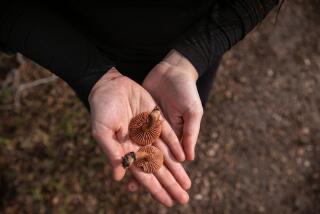Sonoma County farm strikes black truffle gold after 9 years of waiting
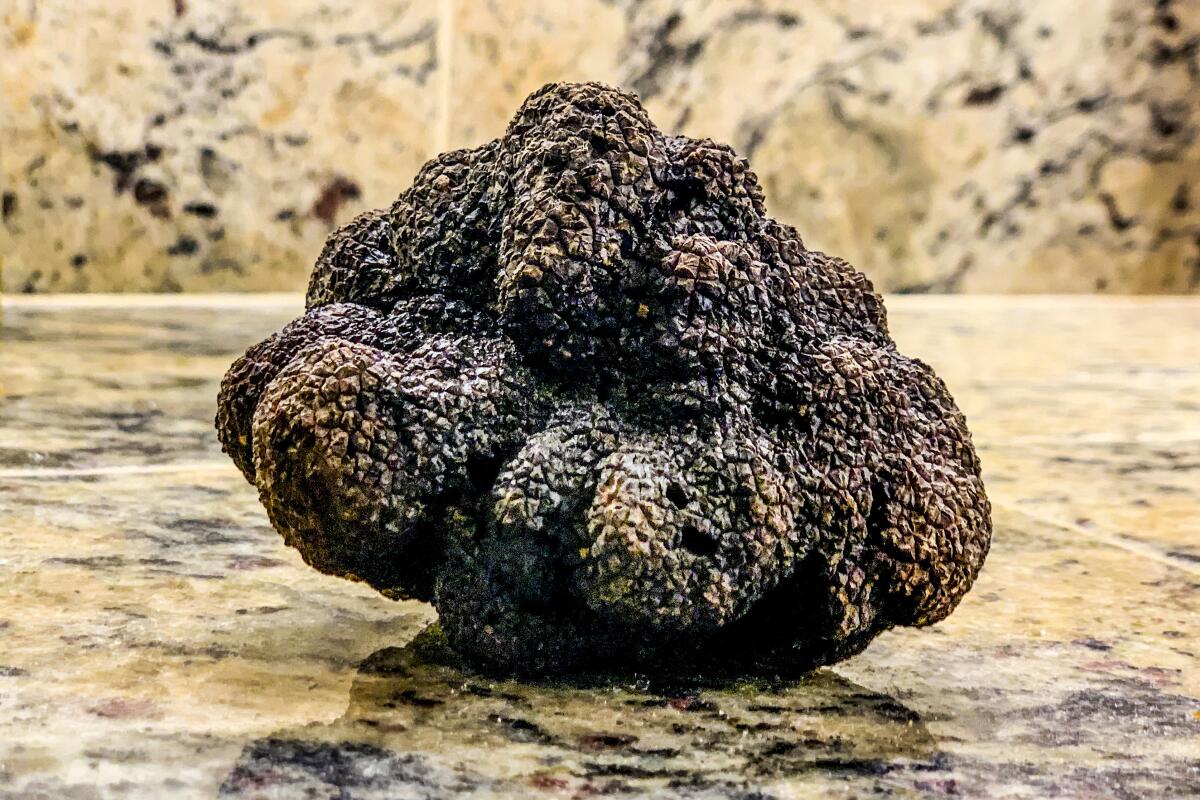
For the past four years, between the months of December and March, Seth Angerer has walked through his family’s orchard in Geyserville, Calif., hoping for a miracle. With his dogs Leo and Vito in tow, he walks the 8 acres, slowly making his way up and down the rows of hazelnut trees. It can take up to three hours to cover the entire farm.
With their tight curly coats and button noses, Leo and Vito look like big stuffed animals. But they’re Lagotto Romagnolos, the only dogs bred specifically to do one thing: Hunt for truffles.
While Angerer walks, the dogs sniff the ground. Sometimes they pull him toward a fence where cats congregate, or toward a rabbit or some stray foliage. Many times the dogs paw the ground as though they’ve discovered the holy grail, only to have it turn out to be a gopher hole or something equally inconsequential. But on the Monday after Thanksgiving, about an hour before sunset, Leo caught the scent of something in the wind — and it wasn’t a gopher.
The dog tugged Angerer about 100 feet, past seven rows of trees. He stopped and eagerly sniffed a patch of dirt surrounded by dried fallen leaves and brush at the base of one of the trees. Instead of aggressively digging into the ground, Leo pawed at the damp soil, a sign he’d found something promising. Angerer pulled Leo away and then knelt down to smell the dirt. He carefully dug his fingers into the ground and found the treasure he had been dreaming about for more than a decade.
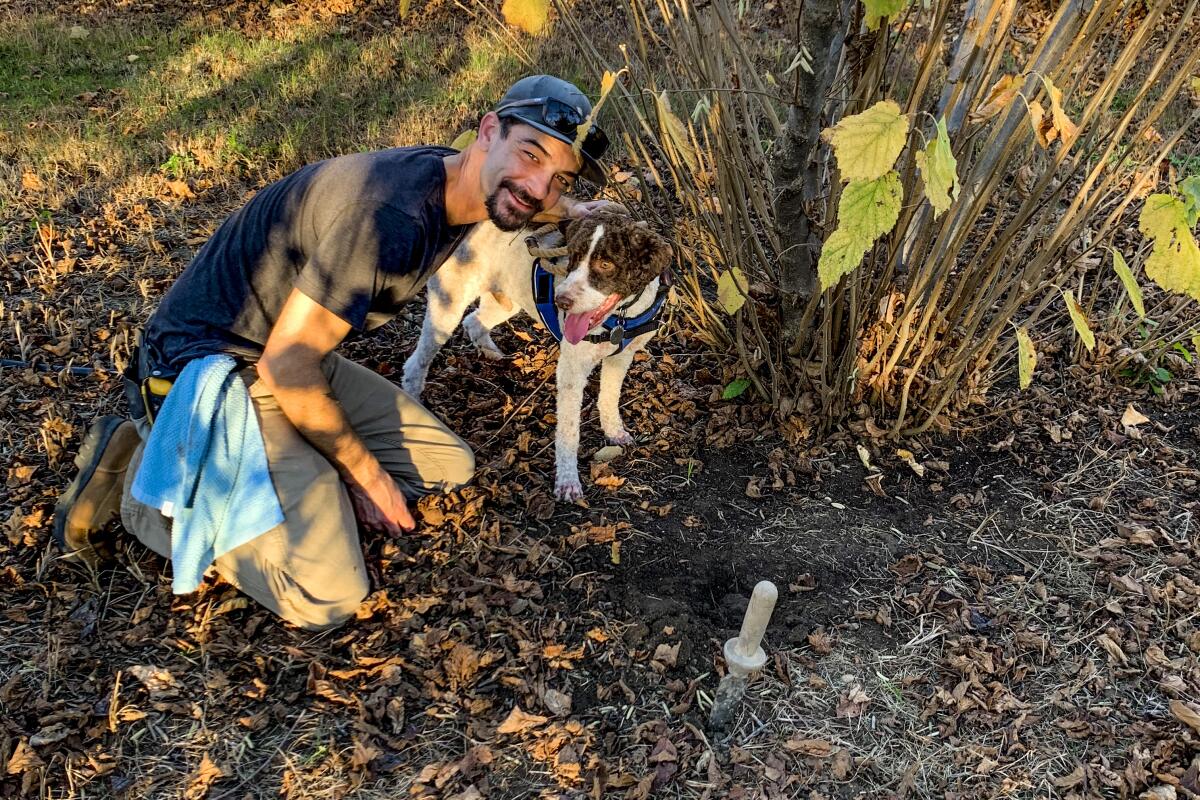
Angerer, 38, had unearthed a black truffle (the Tuber melanosporum variety, also known as the Périgord truffle, named after a region in France where they grow), and he believes it’s the first of its kind to be found in the small Sonoma County town of Geyserville. Weighing 5.2 ounces, the jet-black, misshapen blob, etched with intricate grooves, looked otherworldly. But the Périgord truffle is very much of this Earth, one of the most prized varieties that frequently sells at prices that range from $800 to more than $1,000 a pound.
“I didn’t know who to call first,” Angerer said. “I still had the dog in my hands and I was shaking and trying to dial with my dirty fingers.”
Angerer decided to call his brother Nathan Angerer, 42, who was elsewhere on the property.
“The adrenaline was just … ,” Nathan said. It had been more than a week since the discovery and the excitement in his voice was still palpable. “We’ve been waiting for such a long time.”
::
It was Nathan and his father, Fran Angerer, who started dreaming about truffles more than a decade ago. They work in electrical engineering; Seth is in the entertainment industry. Nathan and Fran, 74, both happened to read the same article in a weekly publication about a Northern Californian who’d successfully grown black truffles, and the family decided to try their hand at cultivating them. The Angerers kept their day jobs but they bought an orchard, planted 1,500 trees inoculated with Tuber melanosporum truffle spores, and formed the Alexander Valley Truffle Company.
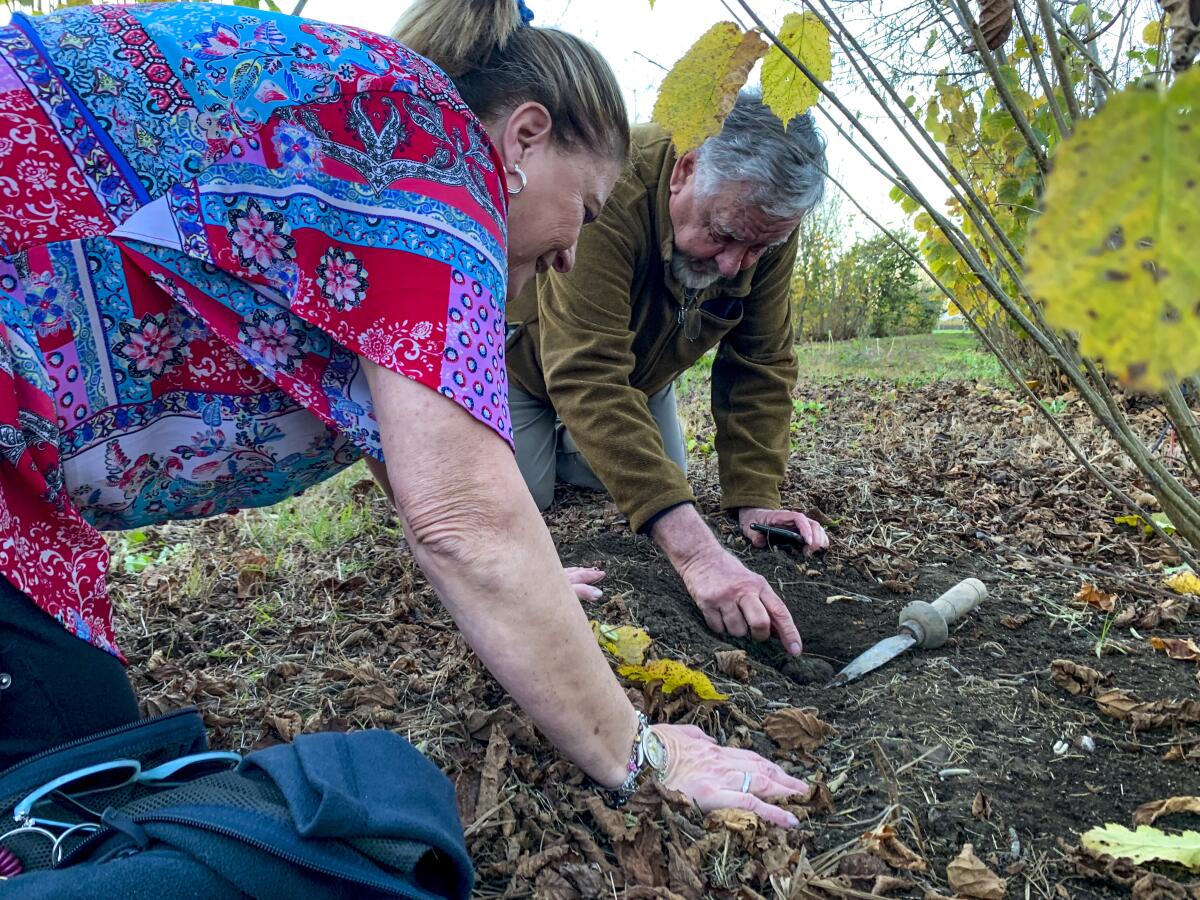
Truffles are a type of subterranean fungus typically found among the roots of specific varieties of trees, including oak, hazelnut, beech, fir, pine and poplar. Their genus, or principal taxonomic category, is Tuber. Some historians believe the prized fungi date back to the Neo-Sumerians and the Babylonians of antiquity. They were a fixture on the tables of Greek and Roman rulers, and the Greek philosopher Plutarch is rumored to have said that truffles were created after Zeus struck an oak tree with one of his thunderbolts.
Today, despite an ongoing pandemic and a struggling restaurant industry, truffles are still a valuable commodity. Prized for their musky, potent, singular flavor and aroma, a couple of shavings on a bowl of pasta or a plate of scrambled eggs can envelop the dish in an earthy embrace of pure luxury. Chefs can charge upward of $50 to dust a single plate with fresh truffles.
According to a report from the market research firm Tech Navio, the U.S. truffle market is expected to increase by $235.23 million from 2020 to 2025 — but truffle farming is rife with uncertainty. There’s an initial investment in the land and trees, and the upkeep of an orchard (irrigation, weed and pest control) is time-consuming and can be costly. What’s more, truffles don’t typically surface, if they surface at all, until five or more years after the trees are planted, and their shelf life is typically short (five to seven days).
For years, the worldwide truffle market has been limited primarily to southern Europe, specifically France, Italy and Spain. But 30-plus years ago California joined their ranks. The first known truffle cultivated in North America was harvested at a truffle farm in Mendocino County in 1987, proving that truffles could indeed be grown outside of Europe.
Recently countries such as Australia, China, Chile, New Zealand and South Africa have started trying to produce their own. And there’s a growing number of farms in the United States producing truffles, many of them located in Northern California, Oregon, Washington, Idaho and North Carolina. In California, truffles have been grown at farms in El Dorado County and Santa Rosa. Jackson Family Wines in Santa Rosa in Sonoma County has been producing truffles since 2017. The production isn’t anything that might sway the world market just yet. In 2019, three farms in Sonoma County produced a total of around 35 pounds of truffles, nowhere near the amount needed to satiate worldwide demand. But that has not diminished the Angerers’ enthusiasm.
“It’s wine country, and truffles are the one culinary product that eclipses ultra-premium grapes in the minds of consumers,” Nathan said.
After conducting their own extensive research and committing to the project, the Angerers knew they were going to need some professional help. They contacted truffle consultant Dr. Charles Lefevre of New World Truffieres, an Oregon company that specializes in truffle cultivation. (Lefevre said truffle orchards tend to cost around $15,000 per acre of land to set up and the price can rise steeply depending on soil amendments, irrigation system, labor, etc.)
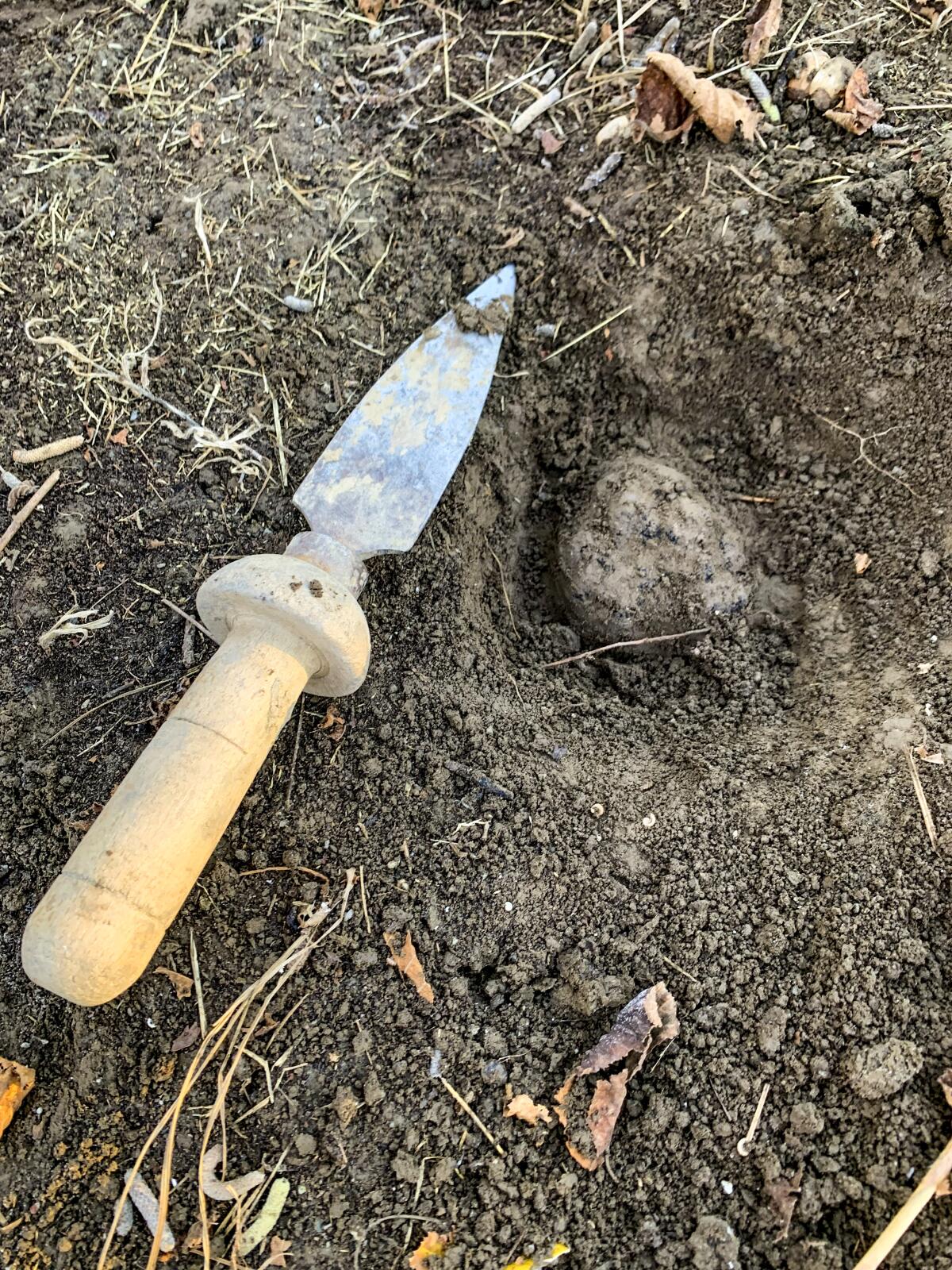
Lefevre, who has a PhD in forest mycology from Oregon State University, started growing, inoculating and selling trees even before he received his degree in 2002. In 2006, he and his wife, Leslie, started the Oregon Truffle Festival in Eugene as an educational forum for growers and harvesters — and anyone interested in truffles. Lefevre also served as president of the North American Truffling Society for almost 10 years.
Lefevre helped the Angerers consult with a soil scientist and offered guidance on the multiple properties considered for the site of a potential orchard. “We were looking for a well-drained, well-structured soil without existing trees on it or immediately nearby and a site with a reliable supply of sufficient irrigation water,” he explained.
Lefevre also provided the Angerers with the hazelnut trees that grow on their farm. Starting with the seedlings, he inoculated the trees with Tuber melanosporum spores and watched them grow at his farm in Oregon for a year before sending them to Geyserville.
The Angerers planted the trees and bought a Lagotto Romagnolo named Tuber in 2014. In the next few years, they took multiple trips abroad to learn about truffle cultivation in Europe. In 2015, Fran and his wife, Robin, 70, traveled to Alba, Italy, and the Istrian peninsula of Croatia; the couple traveled with Seth to Western Australia the following year and added Leo to the family. In 2017, they toured the truffle-growing region of Catalonia, Spain. In the meantime, Tuber was bred with a Lagotto Romagnolo named Rico and produced a litter of seven puppies. The Angerers kept three of them, Vito, Bella and Luke.
Fran trained the dogs using multiple “proprietary methods” that included drilling holes in wine corks, filling them with truffle oil and burying the corks in the dirt. Seth began walking the orchards with Leo and Vito several times a week.
“For the last three years I wouldn’t say I was going to hunt, I would say I was going for a walk because I didn’t want to get my hopes up,” Seth said. “If I go in with that intent, it can get really frustrating.”
Seven years into the operation, Nathan said, they started to lose hope. Nevertheless, in 2019, they planted another truffle orchard, this time in Healdsburg, Calif. Instead of using hazelnut trees, Lefevre supplied the Angerers with 200 English oak and 200 stone pine trees inoculated with Tuber borchii (the fungus that creates white Bianchetto truffles), a variety that sells for around $1,500 and higher per pound.
“Nobody knows how or why or what causes the fruit to reproduce,” Nathan said. “For the Italian whites, if you can produce them and cultivate them, it might take as long as 20 years because it’s such a complex fungus.”
But this year, after countless walks and false alarms, all that waiting paid off.
————
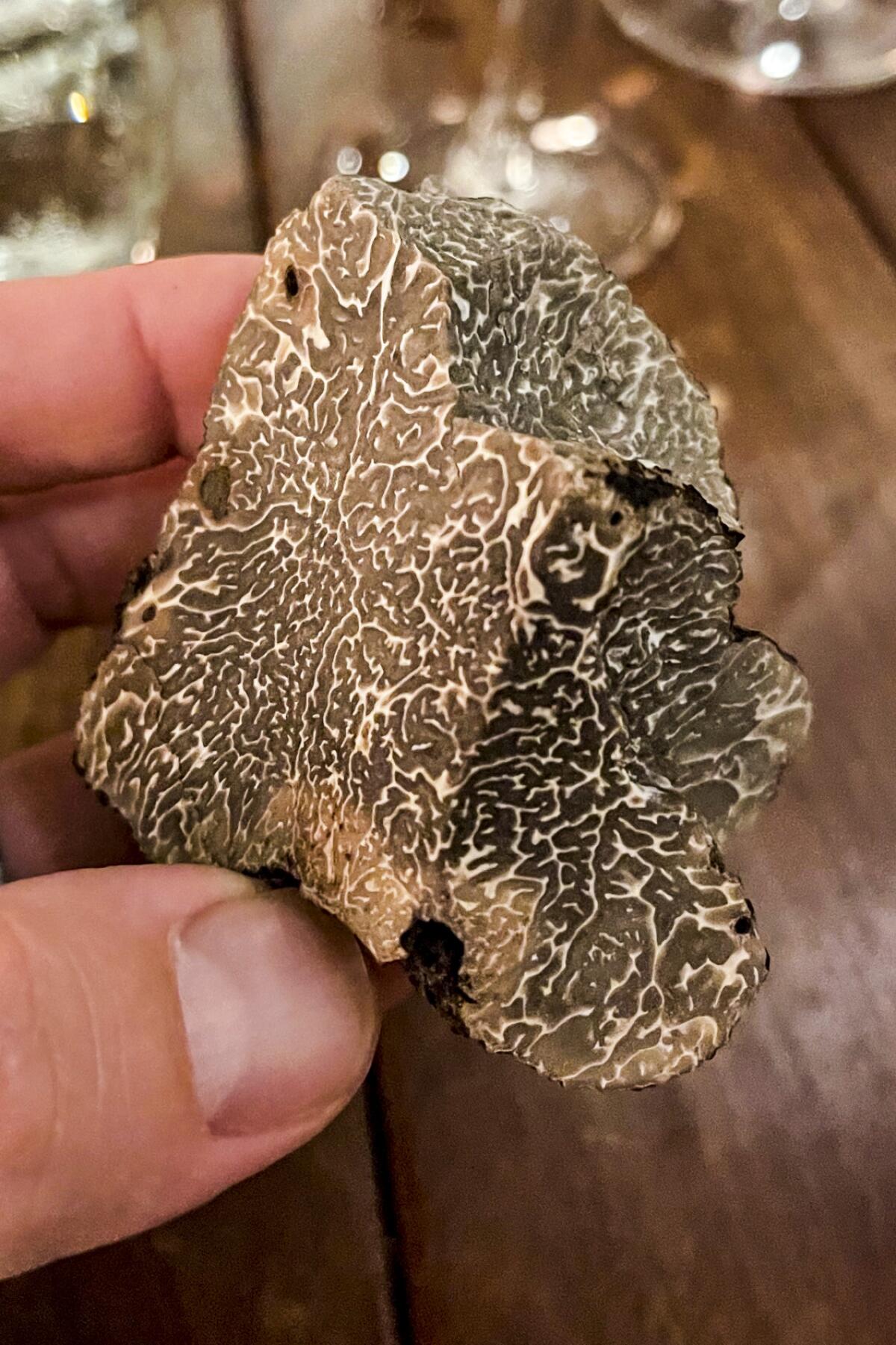
After posting about their first truffle on social media, the Angerers started to receive requests from local chefs for more truffles. Jason Azevedo, the chef at nearby Little River Inn in Little River, Calif., a coastal town about 80 miles north of Geyserville, was one of the chefs who reached out.
“It’s game-changing,” Azevedo said. “It’s exciting to have something where I can go walk the grounds every now and then and have a personal relationship with the grower instead of me ordering truffles that are probably frozen or packed in rice from far away.”
Azevedo typically buys his truffles from a vendor in Italy, and only for special wine dinners or occasions such as Valentine’s Day. Having a local purveyor would mean more truffles, year-round. “To have a local source that was of quality to add to our menu would help us bring another level of service to our guests,” Azevedo said.
But even though multiple parties were interested in buying the truffle, the Angerers decided not to sell. They sent a sliver to Lefevre and then they called Dustin Valette, the chef behind Valette restaurant in Healdsburg, to see if he might cook for them using the truffle. Valette agreed to make the family a five-course tasting meal the very next evening.
Valette, who has worked at multiple Michelin-starred restaurants, has cooked with many truffles over the years. He’s sampled them in Périgord, and he’s visited the Richerenches truffle market in the southeast of France. And he has strong opinions about quality.
There are three components to consider in the evaluation of a truffle, he says: aroma, flavor and color. The aroma is an indicator of the ripeness or depth of the truffle, the darkness of the color will reflect how intense the flavor will be and the flavor can be a sign of how compacted the truffle was in its growth.
“The aroma, for being just one day old, was beautifully perfumed with an intense nose to it, and the flavor was outstanding,” the chef said. “I wouldn’t say it was the best truffle I’ve ever had, but it was definitely in that top five echelons of best ones I’ve ever had.”
A few weeks after the dinner, Valette ran through the courses he served the Angerers.
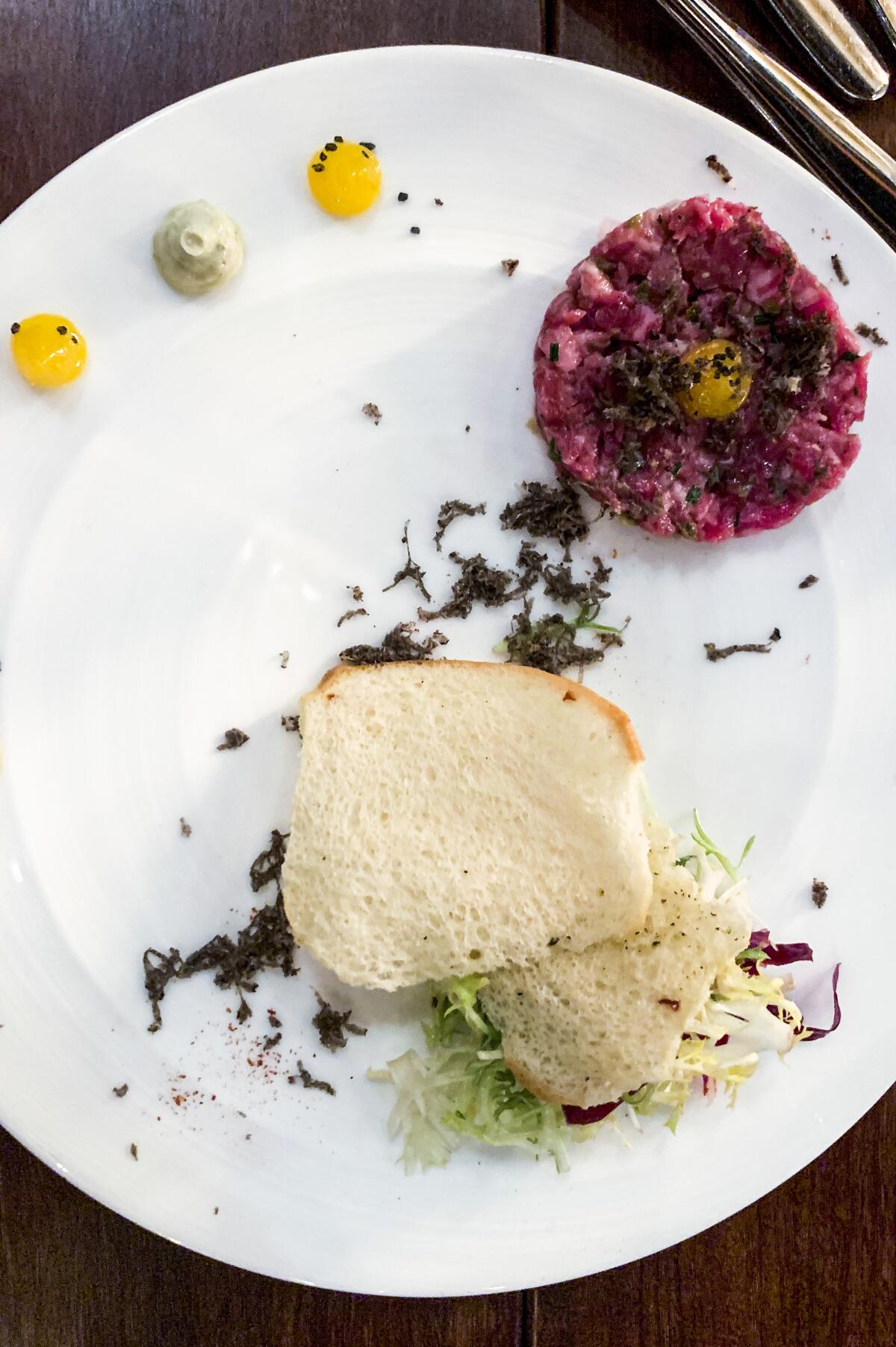
He started the dinner with a seared Kobe beef tartare with sous vide egg yolk and microplaned truffle, followed by fresh semolina pasta with porcini and shaved truffle. Then he served petrale sole with celeriac and more shaved truffle. Next was a Liberty Farms duck with forbidden rice, quince and hazelnuts with shaved truffle. The last savory course was American Kobe New York steak with smoked parsnip, bone marrow and shaved truffle. For dessert? A selection of chocolate-based desserts with more black truffle.
“For us, just to know that they found the very first truffle in our little neck of the woods where I grew up, to have that so close to home and for them to want to come in and share their prized first one with us, is just amazing,” Valette said.
The Angerers are hopeful that the orchard will continue to produce truffles. Finding one is an indication of the soil conditions being just right, and Lefevre, who says 31 of the orchards he supplies with trees in the United States are producing truffles, is confident the Angerers will find more, and soon.
“The Angerers took it seriously from the beginning. They got the tools, got the site for the purpose of growing truffles, and they’ve done everything right from day one,” Lefevre said. “In fact, I was expecting them to find truffles because everything was so perfect.”
But even though Lefevre attributes the success of truffle production to “good farming,” he’s still thrilled when his customers call to report that their orchard is producing truffles.
“I think, besides the grower, I’m the second most excited person,” he said.
Fran said he’d like to call that first truffle — the Périgord— a “Sonoma Winter Black” truffle.
“Ours are better because they are from California,” he said. “I will refer to my product as ‘grown in the U.S.A.’”
More to Read
Eat your way across L.A.
Get our weekly Tasting Notes newsletter for reviews, news and more.
You may occasionally receive promotional content from the Los Angeles Times.

